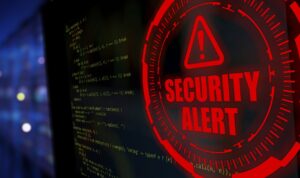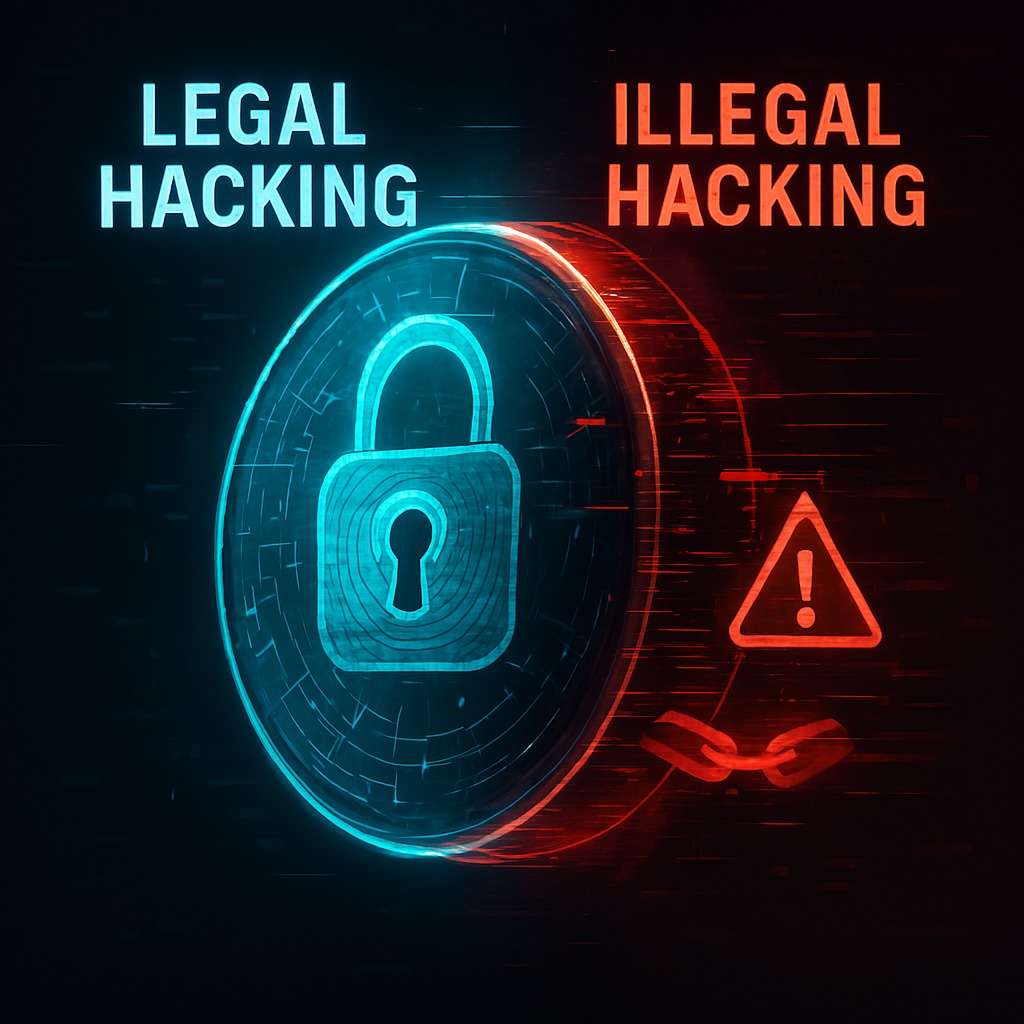Media often portrays hacking as an act of villainy, conjuring images of dark hooded figures breaching secure systems. In reality, the ethics of hacking spans a broad spectrum between legal, constructive activity and illegal, harmful attacks. Understanding the difference between ethical (authorized) hacking and illegal (unauthorized) hacking is crucial for business owners, IT professionals, and students alike. This article explores the core concepts of legal vs illegal hacking, explains why even well-intentioned hacking requires permission, and provides examples and guidelines for staying on the right side of the law.
What is Hacking?

computer screen showing line code
Hacking broadly means attempting to exploit or penetrate computer systems and networks. By definition, hacking often involves unauthorized access or actions. According to Fortinet, “a commonly used hacking definition is the act of compromising digital devices and networks through unauthorized access to an account or computer system”. This unauthorized access is usually what lands hackers in trouble. Hacking is not always malicious, however, and not every exploit is illegal if it has permission and a legitimate purpose.
Types of Hackers: White Hats, Black Hats, and Grey Hats
Not all hackers share the same goals or ethics. White hat hackers (ethical hackers) legally test systems for vulnerabilities, whereas black hat hackers (cybercriminals) break into systems to exploit them. Grey hat hackers operate in between those lines. The ethical and legal distinction often comes down to permission and intent. White hats have permission to probe and strengthen security, whereas black hats break in without consent. Hacking becomes a crime when you access someone’s device or network without permission.
Ethical Hacking (Legal Hacking)
Ethical hacking refers to security testing performed with clear authorization (the ethics of hacking). Organizations often hire ethical hackers to find and fix weaknesses before malicious attackers can exploit them. IBM defines ethical hacking as using hacking techniques by “friendly parties in an attempt to uncover, understand and fix security vulnerabilities in a network or computer system”. In other words, ethical hackers (white hats) use the same methods as cybercriminals, but with the goal of improving security and protecting data rather than harming systems.
White hat hackers follow strict rules to stay ethical. They must always obtain written consent from system owners before testing and agree not to damage data or systems in the process. For example, bug bounty programs (offered by companies like Google and Microsoft) invite white hats to attempt breaking in legally, and any discovered vulnerability is reported back in exchange for a reward. Industry certifications like the EC-Council’s Certified Ethical Hacker (CEH) enforce a firm code of ethics for practitioners. Ethical hackers operate under authorized conditions in planned security assessments conducted with permission.
Top 5 Qualities to Look for When Hiring an Ethical Hacker

Ethical hacking is a proactive security measure. By systematically testing defenses (through methods like penetration testing and vulnerability scanning), ethical hackers help prevent breaches and downtime. Consider bug bounty programs again: companies now openly invite experts to hack their own systems and pay for any flaws found. This transparency not only fixes vulnerabilities faster but also builds trust with customers and partners. It contrasts sharply with illegal hacking (the ethics of hacking), because everyone involved operates openly and with positive intent. In fact, a recent Fortinet study found that 87% of organizations had one or more breaches in the past year, highlighting the need for proactive defense.
Illegal Hacking and Cybercrime

Illegal hacking involves unauthorized and malicious actions against networks or devices. When someone breaks into a system without permission, they are violating both laws and ethics. Under U.S. law, hacking is illegal when done without consent. Black hat hackers have no authorization; they exploit vulnerabilities to steal, damage, or manipulate data for personal or political gain. Classic examples include stealing credit card numbers from an online store, or extorting companies by encrypting their data (ransomware).
The motivations and consequences of illegal hacking are severe. Cybercriminals often target financial gain (e.g., identity theft or selling proprietary secrets) or cause disruption (such as attacks on critical infrastructure). These attacks hurt individuals and businesses alike. For instance, the 2017 Equifax breach exposed personal data of millions and led to significant fines and legal actions. Even broader events – like state-sponsored attacks on national infrastructure – can threaten security at a large scale. Under laws like the CFAA, unauthorized intrusion on protected systems is a federal felony. Convicted hackers may face imprisonment, asset forfeiture, and civil penalties.
Legal vs Illegal Hacking: Laws and Ethics
The key difference between legal and illegal hacking is authorization and intent. Ethical hacking is legal when the hacker has explicit permission from the system owner to test security (the ethics of hacking). In these cases, the hacking activities are collaborative: the goal is to benefit security rather than cause harm. In contrast, any hacking done without permission – even if intended to “help” – is still considered illegal. For example, a security researcher who finds a vulnerability must have formal approval; discovering one without permission is itself against the law.
The ethics of ethical hacking. Ethics play a central role for professional hackers. Ethical hackers follow formal codes of conduct (from bodies like EC-Council and (ISC)²) that emphasize obtaining consent, avoiding harm, and maintaining confidentiality. IBM’s guidelines for ethical hackers explicitly state that they “do not cause any harm” and “keep their findings confidential”. This means white hats never exploit data or publicly disclose vulnerabilities; they report issues only to the consenting organization so fixes can be made safely.
Most countries have strict computer crime laws to enforce these boundaries. In the U.S., for example, the Computer Fraud and Abuse Act (CFAA) makes unauthorized access to a “protected computer” a federal crime. A protected computer includes servers used by banks, hospitals, or government agencies. Practically speaking, hacking almost any internet-connected computer without permission can lead to prosecution. Convicted hackers may face imprisonment, asset forfeiture, and civil penalties.

Grey Hat Hackers and Controversies
Some hackers operate in the grey area between ethical and illegal (The ethics of hacking). Grey hat hackers may scan for vulnerabilities without permission and then report them (sometimes asking for a fee afterward). Their motives can mix altruism and personal interest. Legally, however, intent doesn’t matter: any unauthorized access can break the law. For example, exposing a flaw publicly might force a quick fix, but doing so without permission risks legal punishment and could harm innocent users.
Hacktivism is another controversial realm. Groups like Anonymous hack systems to protest or expose perceived wrongdoing. Supporters claim moral high ground (e.g., fighting censorship or corruption), but these actions usually break laws and can harm innocent parties. Even if the cause seems just, unauthorized hacking is illegal by definition. Many cybersecurity experts encourage following legal channels instead: for instance, organizations now offer official bug bounty programs or coordinated disclosure processes to guide even well-intentioned hackers into lawful paths.
Ethical Hacking in Practice: Careers and Best Practices
The ethics of hacking, ethical hacking has evolved into a respected profession. Many IT and cybersecurity careers focus on legal hacking as a way to strengthen defenses. Students and professionals can pursue training in penetration testing or obtain certifications like CEH (Certified Ethical Hacker) or OSCP. These programs teach hacking tools and techniques – and, importantly, the ethics of hacking. Professionals learn to conduct tests only under written permission and to report all issues they find. They also practice clear, concise reporting to help organizations patch vulnerabilities efficiently.
Businesses benefit when they know how and when to engage ethical hackers. Regular security assessments (often offered by specialist firms) can reveal hidden flaws before attackers exploit them. For example, companies might hire ethical hackers after deploying new systems or on a regular schedule to ensure continued safety. Guides like our Ultimate Guide to Ethical Hacking explain why these services matter. Likewise, understanding when to hire a hacker helps companies decide the right time to engage experts.
Participating in ethical hacking can also be educational. Students and tech enthusiasts can practice on legal platforms like Capture the Flag competitions or sandbox environments. There, hacking skills are applied responsibly and safely. The overarching rule is clear: without permission, hacking is a crime. With authorization and ethical intent, hacking becomes a powerful tool for protection.
Conclusion
Ultimately, the ethics of hacking hinges on consent and outcomes. Ethical hacking – the legal side – involves helping organizations secure their systems through authorized testing and vulnerability discovery. Illegal hacking, by contrast, is unauthorized and malicious, leading to data theft, system damage, and legal punishment. By staying within the bounds of permission, following strict rules of engagement, and focusing on defense, hackers can use their skills for good (The ethics of hacking). This clear distinction ensures that cybersecurity remains a force for protection rather than harm.



No responses yet